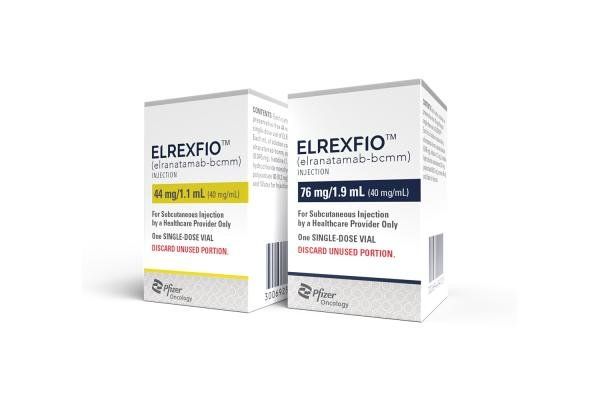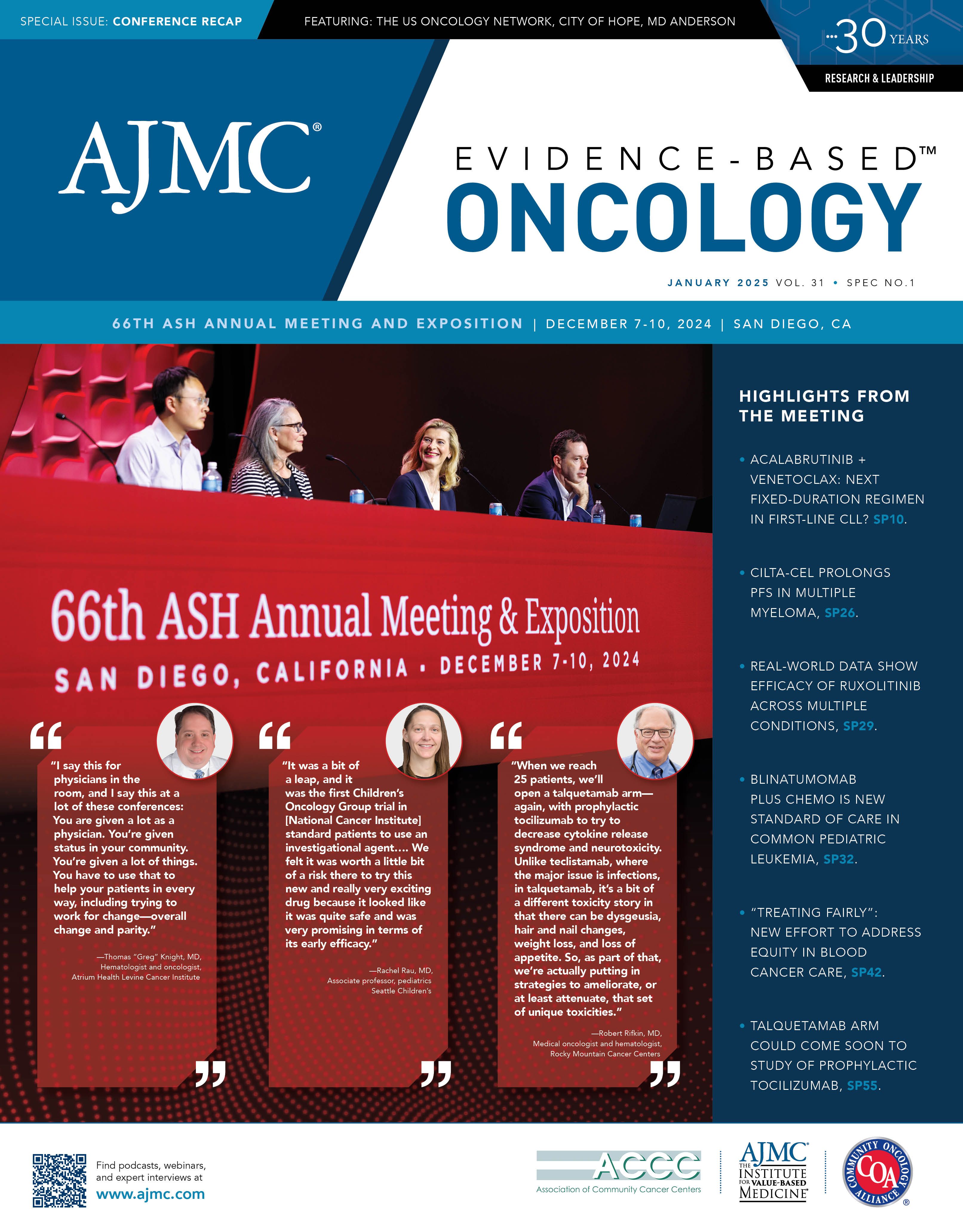- Center on Health Equity & Access
- Clinical
- Health Care Cost
- Health Care Delivery
- Insurance
- Policy
- Technology
- Value-Based Care
MagnetisMM-20: Priming Myeloma Tumor Cells for the Bispecific Bout
Results of a small study presented at the 66th American Society of Hematology Annual Meeting & Exposition suggest combining the bispecific elranatamab with the proteasome inhibitor carfilzomib can bring responses even in patients with stage III disease.
Bispecific antibodies have been big news for several years at the American Society of Hematology Annual Meeting & Exposition (ASH), and the 66th session in San Diego, California, held December 7-10, 2024, offered more possibilities—such as MagnetisMM-20 (NCT04649359), a small phase 1b trial in relapsed/refractory multiple myeloma (RRMM). This study evaluated the efficacy of elranatamab (Elrexfio, Pfizer), which targets B-cell maturation antigen (BCMA) on myeloma cells and CD3 on T cells, in combination with carfilzomib, a second-generation proteasome inhibitor, and dexamethasone.1
At present, the FDA has approved elranatamab for patients with multiple myeloma who are relapsed/refractory after at least 4 other treatments.
Results presented at ASH 2024 follow a phase 2 study, MagnetisMM-3 (NCT04649359), in which elranatamab alone “induced deep and durable responses.”2 Patients in the new study had been treated with 1 to 3 prior lines of therapy, but no prior BCMA-directed therapy. Earlier treatment with carfilzomib was permitted if patients had at least a partial response to a regimen with carfilzomib, did not stop treatment due to toxicity, and had not relapsed within 60 days after treatment ending.
In the MagentisMM-20 regimen, patients received a “priming dose” of premedication and 2 step-up doses of subcutaneous elranatamab before they received the first full dose of the bispecific; this was either dose level 1 of 44 mg or dose level 2 of 76 mg. Those who received elranatamab for at least 6 months of weekly dosing, with a partial response lasting at least 2 months, would switch to a biweekly schedule. Carfilzomib was given intravenously on a ramp-up schedule and then given on days 1, 8, and 15 of each 4-week cycle, with dexamethasone given weekly.
Elrexfio packaging | Image credit: Pfizer

The primary end point is dose-limiting toxicity through the first 42 days; secondary end points include adverse events (AEs) and laboratory abnormalities. Secondary efficacy end points include best overall response, objective response rate (ORR), complete response rate, time to response (TTR), duration of response (DOR), and progression-free survival, all based on International Myeloma Working Group criteria, and overall survival.
Results showed the following:
- 12 patients were treated in the first phase; their median age was 66 years and all were male; none had extramedullary disease (EMD), 3 had high-risk cytogenic abnormalities. Patients with stages I,II, and III disease were represented in the study, based on the Revised International Staging System for Multiple Myeloma
- Patients had a median of 2 prior lines of therapy; none had a stem cell transplant
- At the time of data cutoff (February 22, 2024), 91.7% were still receiving elranatamab and carfilzomib, and 66.7% were still receiving dexamethasone. Median duration of treatment was 3.15 (range, 0.56-13.37) months
- 10 patients were evaluable for dose-limiting toxicities; none were reported at either dose
- The most common AEs of any grade, affecting at least 50% of patients, were fatigue, cytokine release syndrome (all grades 1-2), neutropenia, thrombocytopenia, injection-site reaction, and leukeopenia; onfections, all grade 1-2, were seen in 75% of patients
- Grade 3/4 AEs were fatigue (8.3%), neutropenia (33.3%), thrombocytopenia (25.0%), leukopenia (16.7%), anemia (25.0%), lymphopenia (25.0%), and peripheral edema (16.3%)
- At a median follow-up of 3.24 months, unconfirmed ORR by investigator was 100%; 10 patients had confirmed ORR with a median TTR of 1.41 (95% CI, 0.53-3.35) months; the median DOR was not reached
The American Journal of Managed Care® (AJMC®) asked presenting investigator Michael Tomasson, MD, professor of internal medicine-hematology, oncology, and blood and marrow transplantation at the University of Iowa, for additional insights:
AJMC: Can you discuss how the mechanism of the bispecific antibody (elranatamab) and the proteasome inhibitor (carfilzomib) work synergistically to activate the immune system against cancer?
Michael Tomasson, MD | Image credit: University of Iowa

Tomasson: Elranatamab is a bispecific antibody that binds to the BCMA on the tumor cells and the CD3-positive bone marrow immune cells, bringing T cells into contact with the tumor cells for destruction. Carfilzomib is a second-generation proteasome inhibitor, and preclinical studies have shown that proteosome inhibition primes the cells for immune-mediated destruction. The idea is that the immune priming of the tumor cells by carfilzomib makes the myeloma cells even more sensitive to elranatamab.
AJMC: Discuss the role of the priming dose. Did this work as anticipated?
Tomasson To clarify, the “priming dose” was escalating doses of a single agent, and no dose-limiting toxicities were found. Then in cycle 1, patients received elranaramab plus carfilzomib, and we did see evidence of potential cooperation with the doublet. It’s a small study with 12 patients, but in the MM-3 registration trial where elranatamab was used alone in RRMM, there were very deep and long-lasting remissions in a broad variety of patients. However, patients with R-ISS stage III did not fare as well. In the MM-20 study, we found that even stage III patients in the combination group responded with deep and long-lasting remissions, which give us hope that with continued enrollment into the study, we will see the effects of cooperation.
AJMC: The study reported 100% ORR, with 75% of patients reporting infections. Are there strategies you can pursue in a larger study to reduce the infection rate?
Tomasson: Yes. We learned that through the course of this study, as well as other studies, that Intravenous immunoglobulin is protective against infection in these patients, so its use should be routine and prophylactic. The other thing we found was reactivation of cytomegalovirus (CMV). Although these reactions were asymptomatic, CMV levels should be monitored routinely.
AJMC: No patients had EMD, but would you rule out this regimen for those patients?
Tomasson: I would not rule it out, but I do think that plasma cell leukemia, EMD, and ultra-high-risk disease deserve continued studying.
AJMC: As treatment of even newly diagnosed MM now features quadruplet therapy, does this regimen address the need to develop treatments for those patients who will need additional options?
Tomasson: Yes, I think that’s what this shows. Single agent elranatamab in low-stage patients, or combo therapy in high-stage patients has the promise for deep and long-lasting remissions after failure of quadruplet therapy.
References
1. Tomasson MH, Gabayan E, Ali SA, et al. Efficacy of elranatamab (ELRA) in combination with carfilzomib (CFZ) and dexamethasone (DEX) in the phase 1b MagnetisMM-20 trial in relapsed or refractory multiple myeloma (RRMM). Blood. 2024;144(suppl 1):1024. doi:10.1182/blood-2024-210520
2. Lesokhin AM, Tomasson MH, Arnulf B, et al.Elranatamab in relapsed or refractory multiple myeloma: phase 2 MagnetisMM-3 trial results. Nat Med. 2023;29(9):2259-2267. doi:10.1038/s41591-023-02528-9

The Importance of Examining and Preventing Atrial Fibrillation
August 29th 2023At this year’s American Society for Preventive Cardiology Congress on CVD Prevention, Emelia J. Benjamin, MD, ScM, delivered the Honorary Fellow Award Lecture, “The Imperative to Focus on the Prevention of Atrial Fibrillation,” as the recipient of this year’s Honorary Fellow of the American Society for Preventive Cardiology award.
Listen
